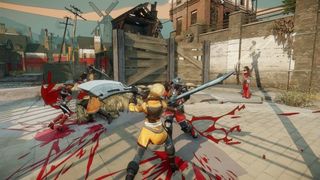Battlecry hands-on: swinging blades in Bethesda's new F2P action game

Bethesda is making a free-to-play, third-person multiplayer action game called Battlecry. Announced today as a PC exclusive, Battlecry is in the hands of a new team that formed in 2012 specifically for the project, BattleCry Studios. Earlier this month I was invited to play Battlecry with other members of the press, and today I can share what I thought of it after a few rounds.
Broadly, Battlecry felt like a mostly-melee cousin to Team Fortress 2 played in third-person. The most noticeable similarity is in Battlecry's art, which bears Team Fortress 2's smoothness and color palette (and why wouldn't it, with ex-Valve art director Viktor Antonov working on Battlecry); one map we were shown had a spiraling, vertical piece of machinery that looked a lot like an 18th-century Granary. There's an assassin class character, the Duelist, who can go fully invisible like TF2's Spy. And while there's no Medic class, each character can spend “adrenaline,” which fills by notching kills, to make their fighter nearly invincible and much stronger for a brief time—effectively a Kritzkrieg and ÜberCharge rolled together.
The moment-to-moment combat of Battlecry felt loose and arcadey, a bit like Smite, but more frantic and played at much higher speed. I had a lot of success as the Enforcer class, the tank of the five total playable characters, who wields a massive sword that reminds me of Cloud's Buster blade in Final Fantasy VII. I'd wade into a pack of enemies who were already engaged, dropping a radial attack to swirl my blade around me like an Olympian preparing to throw a hammer.

It might've been the inexperience of me and the other press playing Battlecry for the first time, but most of the encounters came down to numbers and attrition rather than execution, it felt like. Teammates would swarm, everyone would focus on a single target, and we'd eventually scatter or encounter a group bigger than ours, die, respawn, and repeat. There was very little synergy on display between the classes, and no reason that I experienced to pause, wait, communicate, or plan a deliberate attack. Admittedly, only three of the five classes were available to play—the last being the Tech Archer, a ranged specialist.
Uninspiring as this first hands-on was, I ended the demo with some appreciation for how agile characters are in Battlecry. Your base footspeed is a step or two below TF2's Scout, and granting everyone with that kind of velocity made for a few fun pursuits and evasions during my demo. Something this speed seemed to undermine, though, was the sense of flow and permanence to the match—because everyone could move so quickly, there was never any sense of a frontline or progress to our matches, just dozens of players scrambling around the open, unobstructed maps to find each other, mash their abilities, and search for more targets.

Multiplayer melee games have been a tiny trend in the past year or two (War of the Roses, Chivalry), and I'm glad to see another game join that fray. After playing Battlecry, though, I don't have a clear read on what it'll offer to pull me away from the other multiplayer games I'm devoted to. The maps we played felt needlessly spacious, and Battlecry felt too loose in its hit detection and movement to be a good candidate for a game I'd play competitively. On the other hand, it also didn't have many of the trappings of a great, playful casual game; its seriousness wasn't contrasted by wry one-liners or dark humor, just the brightness of its art.
Battlecry's adoption of some of TF2's traits is a good approach, but I worry that the game is arriving at a time when the sun feels like it's setting on TF2's appeal (probably the third or fourth most-played game on Steam today, admittedly). It'll be interesting to see what else Battlecry will have to offer—and how players respond to it—when it goes into beta in 2015.
The biggest gaming news, reviews and hardware deals
Keep up to date with the most important stories and the best deals, as picked by the PC Gamer team.

Evan's a hardcore FPS enthusiast who joined PC Gamer in 2008. After an era spent publishing reviews, news, and cover features, he now oversees editorial operations for PC Gamer worldwide, including setting policy, training, and editing stories written by the wider team. His most-played FPSes are CS:GO, Team Fortress 2, Team Fortress Classic, Rainbow Six Siege, and Arma 2. His first multiplayer FPS was Quake 2, played on serial LAN in his uncle's basement, the ideal conditions for instilling a lifelong fondness for fragging. Evan also leads production of the PC Gaming Show, the annual E3 showcase event dedicated to PC gaming.
Most Popular

